|
Jan
07
2025
|
|
Posted 354 days ago ago by Admin
|
|
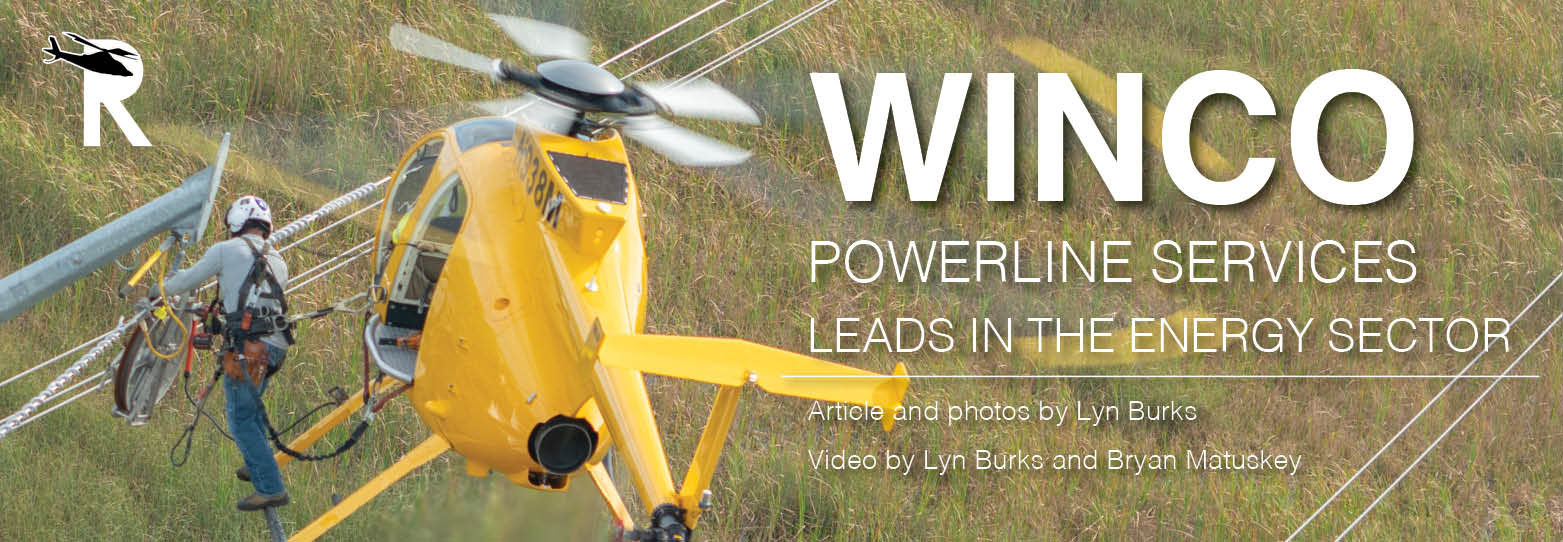
WATCH VIDEO
Helicopters play a pivotal role in the energy sector, offering unique advantages for construction, inspection, and maintenance tasks. Their versatility, speed, and ability to access hard-to-reach locations make them indispensable in supporting energy infrastructure projects, particularly in remote or challenging environments.
Winco Powerline Services (owned by parent company Quanta Services) bills itself as a power-line construction specialist. But before we dive into the details of this 33-year-old, highly specialized helicopter operator, let’s take a high-level look at how helicopters are used in the broader energy sector.
Construction Support
In the construction phase of energy projects, helicopters are invaluable for transporting materials and equipment to areas that are difficult or impossible to access by conventional means. This is especially true for projects in mountainous regions, offshore locations, or dense forests. Helicopters can deliver heavy loads such as steel beams, turbines, and electrical components directly to construction sites, significantly reducing the time and labor required for ground transportation.
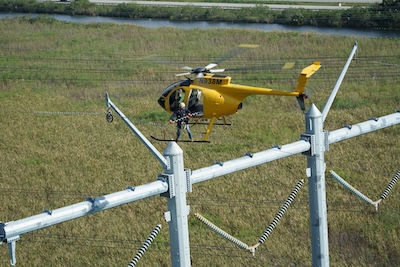
For example, in the construction of wind farms, helicopters are often used to transport and position large components like turbine blades and nacelles. Their precision and ability to hover make them ideal for placing these components in areas where cranes and trucks cannot operate efficiently. Similarly, in hydroelectric projects, helicopters assist in carrying and installing materials for dam construction, pipelines, and transmission lines in rugged terrains.
Inspection and Monitoring
Once energy infrastructure is operational, helicopters become essential for routine inspections and monitoring. Power lines, wind turbines, solar farms, and oil and gas pipelines require regular checks to ensure they are functioning optimally and to identify potential issues before they lead to failures.
Helicopters equipped with advanced imaging and sensing technologies can conduct aerial inspections quickly and effectively. Infrared cameras, LiDAR systems, and high-resolution photography enable operators to detect problems such as overheating components, structural damage, or vegetation encroachment on power lines. These inspections are conducted while minimizing disruptions to operations, as helicopters can cover vast areas in a fraction of the time it would take ground crews.
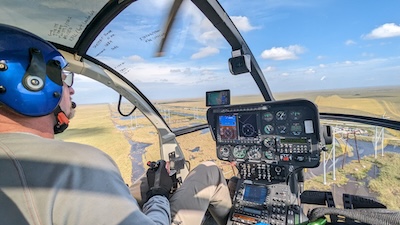
In the oil and gas sector, helicopters are frequently used to monitor pipelines and offshore platforms. They provide real-time data on the condition of infrastructure and can quickly respond to emergencies such as oil spills or equipment malfunctions. The ability to rapidly assess and address issues reduces downtime and prevents costly repairs or environmental damage.
Emergency Response and Maintenance
Helicopters also play a critical role in emergency response and maintenance. In the aftermath of natural disasters such as hurricanes, earthquakes, or wildfires, energy infrastructure often sustains significant damage. Helicopters can swiftly transport repair crews, tools, and replacement parts to affected areas, enabling quicker restoration of power and services.
Moreover, helicopters are used to perform live-line maintenance on high-voltage power lines. This specialized work requires skilled technicians who are transported by helicopter to the power lines, where they conduct repairs while the lines remain energized. This method ensures uninterrupted power supply while addressing maintenance needs.
Enter Winco Powerline Services
One helicopter operator with 33 years of experience in performing this type of work is WINCO Powerline Services. Founded by Gordon Winfrey (a former military pilot) in 1992, the company started with only one helicopter, an MD500 (N11054), which is still in service with Winco today having over 20,000 hours on the airframe. Regarding the high-time airframe, according to Trever Walker , Winco’s director of operations, “It’s been refurbished, is the pride of the fleet and is a nice looking aircraft.”
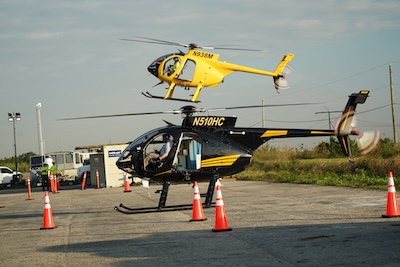
In 2008, Winfrey sold the company to Quanta Services, and today Winco operates a fleet of nine MD 500 helicopters. Four of them are MD500 D models with the C20R engine and the remainder are the latest MD530 F models.
Trever Walker, Winco’s director of operations has been an aviator for three decades, working in the energy sector for 17 years. Interestingly, his grandfather had a helicopter company formed in 1963, using Bell 47s for agriculture work. Walker reminisces that his first helicopter ride was at age 5, and he still has the photo of that influential flight on his desk. So once Walker got his helicopter ratings, he had to work his way into a pilot position. “There were no freebies for me, I spent years driving fuel and batch trucks trying to work my way into a pilot position,” said Walker. That experience allowed him to work his way into several flying jobs in the energy sector, which ultimately landed him at Winco in 2012.
Winco operates mostly under an External Load Operations Certificate provided by FAR Part 133. Depending on the type of operation, crews will operate in the power-line environment utilizing a variety of external load classes. Here’s a primer on the different types of external loads that may be deployed:
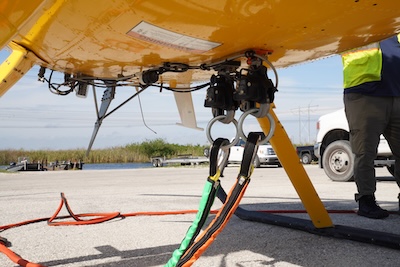
Class A External Loads - Class A external load is one in which the external load cannot move freely, cannot be jettisoned, and does not extend below the landing gear. Carriage of supplies in an approved cargo rack or bin or a seat affixed to the exterior of the aircraft, to be occupied by a power-line repairman or a cameraman, could be examples of a Class A external load.
Class B HEC External Loads - Class B is an external cargo load that can be jettisoned and is lifted free of land and/or water by a cargo hook or winch. An example of a Class B load operation would be human external cargo, or the placement of an air conditioning unit on the roof of a tall building.
Class C External Loads - Class C is an external cargo load that can be jettisoned and remains in contact with land or water. An example is a wire-stringing operation at a construction project.
Class D External Loads - Class D is an external cargo load other than Class A, B, or C and approved on an individual basis through the issuance of LOA A044. An example would be an operation involving the carriage of an individual in an FAA-approved personnel lifting device. Class D authorization has special considerations, especially in terms of operating rules.
Winco currently has approximately 64 team members with 22 pilots, 19 mechanics, and the remainder being linemen and administrative staff.
Pilots are trained at both the MD factory training facility in Mesa, Arizona and also receive training in-house. Biennial flight reviews, which include emergency-procedures training for pilots, is performed by MD Helicopters factory instructors and include full-touchdown autorotations. There’s additional in-house training during the year to maintain proficiency and currency in specific operations relative to performing power-line work.
One unique training course that is proprietary to Quanta Services (Winco’s parent company) is the “Barehand Awareness Course” given to all pilots at Quanta’s training facility in Texas called the Lazy Q Ranch. The three-day course gives pilots the opportunity to go hands-on with energized 345,000 V lines to gain a better understanding of how the voltage is impacting personnel and aircraft.
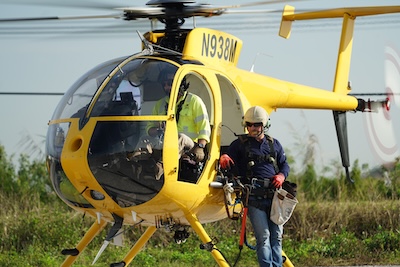
Winco’s helicopters are all maintained by the company. The highest quality maintenance is what keeps Trever loyally remaining at Winco. Trever proudly points out that he believes that Winco has the best maintenance in the industry and attributes it to the company’s dedicated team of skilled mechanics and the leadership of Director of Maintenance Shane Lair.
Getting the Work Done
Winco performs its work all over the contiguous United States and has also worked in Alaska. Crews work three-week-on and three-week-off schedules and travel to ongoing projects. Any work related to new power-line construction or rebuilding lines is the bread-and-butter of Winco. Line pulling, installing insulators and bird diverters, as well as placing marker balls are all specialized tasks that suit the company’s experience. In 2024, Winco averaged over 800 hours per helicopter and pulled over 5,500 miles of sock lines.
Winco’s ability to perform and complete large and challenging projects are well known in the industry and in 2024 they worked on projects from California to Maine and many places in between. Currently, Winco has four aircraft supporting the largest renewable energy project in the history of the United States installing infrastructure from Albuquerque, New Mexico, all the way down to Tucson, Arizona.
Another monumental task was that of constructing a transmission line going from Rawlins, Wyoming, down to Salt Lake City, Utah, which is very challenging and inhospitable terrain. Phase Two of that project was to install over a thousand lighted marker balls on the lines. This project was the first time the crews were able to utilize a new technology, developed by one of Quanta’s subsidiary companies, in the form of voice-guided GPS.
Developed to make placing marker balls more efficient and running on an Android OS, crews use an app that shows the exact location of the aircraft relative to the powerlines and the exact location of where the marker balls are to be placed on the line. As the pilot navigates down the line, the voice-guided GPS generates audible commandsL: “30 feet ahead on line. 20 feet ahead on line. 10 feet ahead on line. One foot ahead on line. Place. Place. Place.” This new technology replaces a manually installed measuring wheel, which is placed on the static line and pulled down the line.
Another challenging project was to fly an aircraft up to Kodiak Island, Alaska. The task was to perform some inspection work as well as to replace old marker balls with new ones. Flying up to Alaska and performing the work went off without a hitch. However, while returning back to the Lower 48, the weather conditions deteriorated and Walker had to put the aircraft down on a beach near Yakatat, Alaska. “When they say Alaska weather changes fast, it's no joke; it changes quick,” said Walker. Due to IMC conditions, Walker and his teammate had to spend the night on the beach with the helicopter. Thankfully, the aircraft was equipped with survival gear and a weapon for bears. Also with no cell or radio coverage in this area, the only way they were able to communicate with their company to let them know they were OK was via Spider Text through the on-board Spidertracks aircraft tracking system.
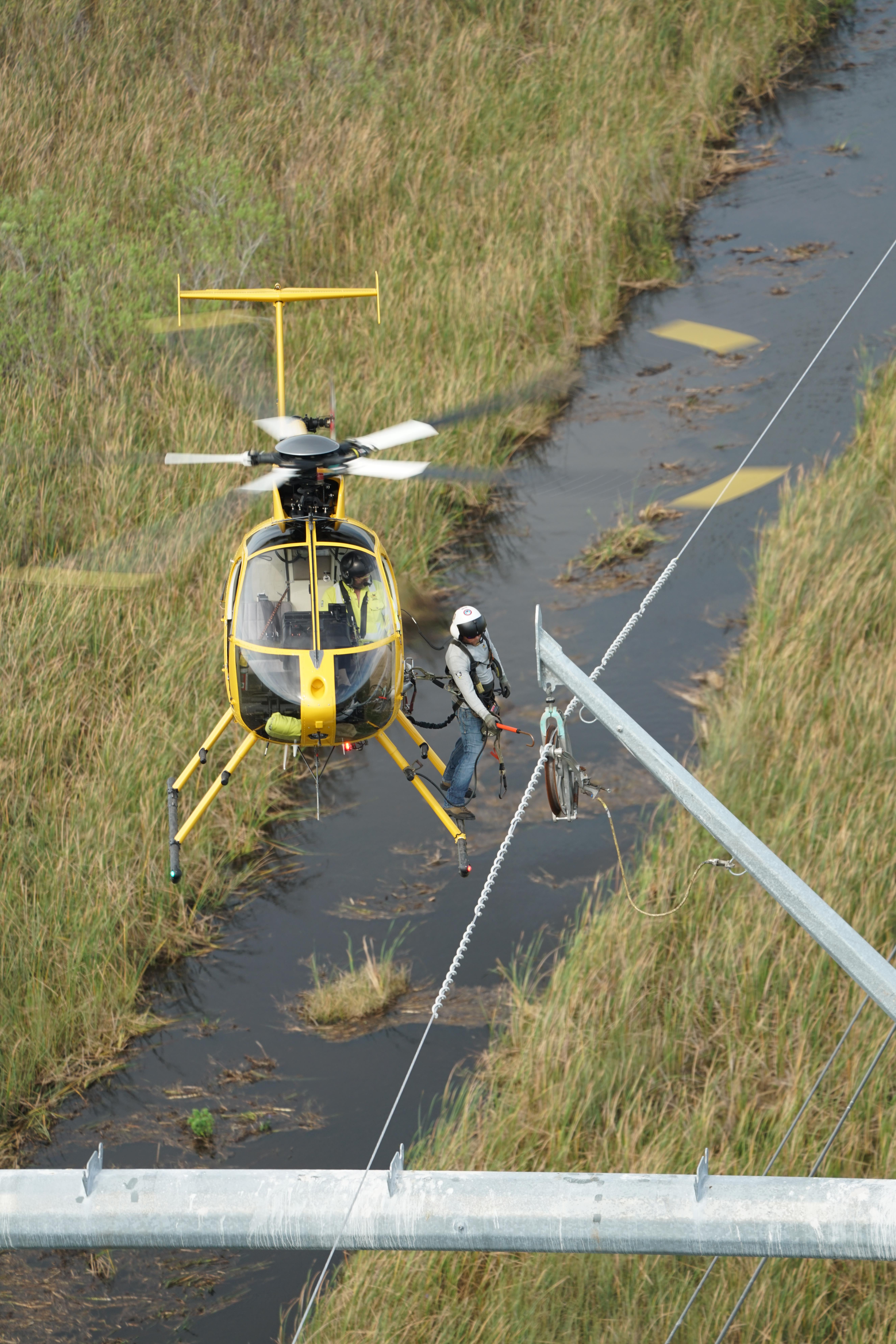
Conclusion
The use of helicopters in the energy sector underscores their importance in modern infrastructure development and maintenance. By enabling efficient transportation, precise construction, and comprehensive inspections, helicopters help ensure the reliability and sustainability of energy systems. As the demand for renewable energy grows and infrastructure expands into increasingly remote areas, the role of helicopters, as well as uncrewed aerial platforms are likely to become even more significant, driving innovation and efficiency in the energy industry. One thing is for sure, with three decades of professional experience, and a highly trained team of professional pilots, mechanics and lineman, Winco will be leading the way.
EDITORS NOTE: Recent News Impacting External Load Operators
The FAA has issued a revised policy for the harnesses used for fall protection by utility lineworkers when performing human external cargo (HEC) operations. This decision ensures uniformity, enhances safety, and promotes operational compliance with existing local, state, and federal safety rules.
Vertical Aviation International (VAI) recently urged the FAA to broaden the scope of the nationally recognized standard for HEC harnesses to address discrepancies between FAA and OSHA regulations for full-body harnesses. These discrepancies created a fragmented operational framework, posing significant compliance challenges for operators and utilities alike.
VAI’s regulatory team urged the FAA to align federal policies with the consensus ANSI standard, which is accepted by OSHA, utilities, unions, and harness manufacturers. The American National Standards Institute (ANSI), a private nonprofit organization, develops widely respected standards for products, services, and systems recognized by both industry and government. The FAA’s updated policy recognizes that harnesses compliant with ANSI/ASSP Z359.11 meet or exceed performance requirements and can be safely used in HEC operations.
The FAA’s policy statement (PS-AIR 27/29.865) emphasized that these harnesses remain subject to rigorous maintenance, inspection, and retirement protocols to ensure their continued reliability and durability. “This policy change is a testament to the importance of collaboration between industry and regulators,” says James Viola, president and CEO of VAI. “By adopting the ANSI standard, the FAA has not only enhanced safety but also simplified the regulatory landscape for operators and utilities working to maintain our national power grid.”
Viola adds that in addition to enabling greater operational consistency and reducing compliance burdens, the new policy will ultimately allow for greater innovation in harness design that both meets ANSI specifications and better protects utility lineworkers.
WATCH VIDEO
READ MORE ROTOR PRO: https://justhelicopters.com/Magazine
WATCH ROTOR PRO YOUTUBE CHANNEL: https://buff.ly/3Md0T3y
You can also find us on
Instagram - https://www.instagram.com/rotorpro1
Facebook - https://www.facebook.com/rotorpro1
Twitter - https://twitter.com/justhelicopters
LinkedIn - https://www.linkedin.com/company/rotorpro1